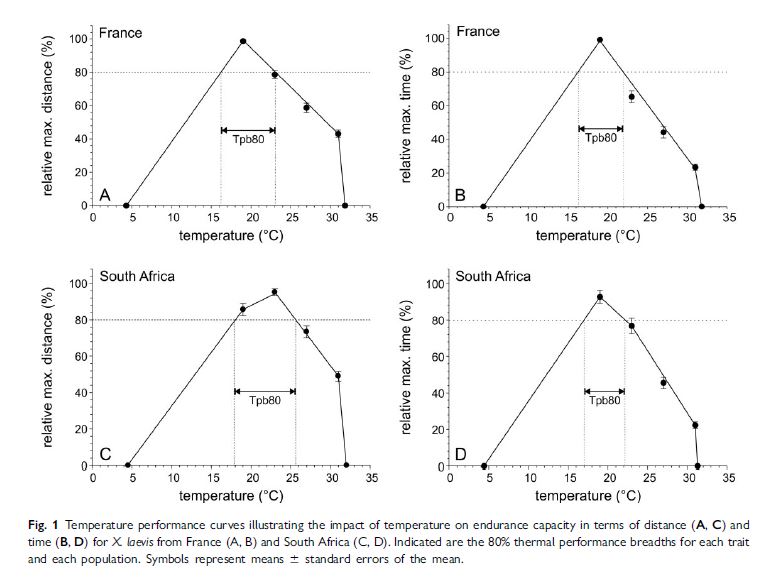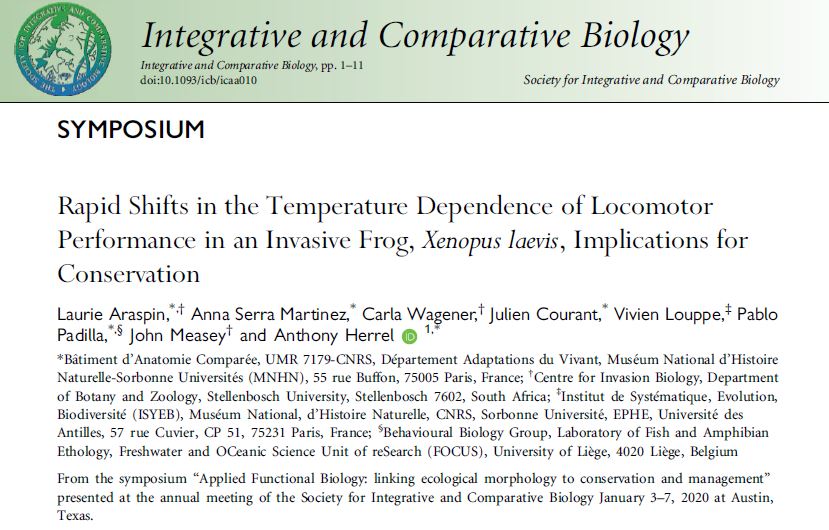After ~40 years in France African clawed frogs are adapted to the cold
In order to accurately model the potential distribution of expanding populations of ectothermic invasive species, we need accurate models that determine how they perform in different thermal environments. The model amphibian, the African clawed frog (Xenopus laevis) has had many studies on thermal preferences of laboratory bred populations that could be used in species distribution models. However, this would assume that laboratory bred animals have not adapted from the wild-type, or that introduced populations themselves have not undergone thermal adaptation.
A new study by Araspin et al (2020) used populations of clawed frogs from two sites in their native South Africa as well as from the invasive French population to test whether any adaptation had occurred in thermal performance in the ~40 years since their introduction. Surprisingly, French invasive frogs showed a significant rapid shift in their thermal dependence of locomotor performance, meaning that they perform better at colder temperatures than wild caught animals.

The implications of this finding are that the population of invasive frogs currently undergoing expansion in France will be able to penetrate more temperate European climates. Hence distribution models that were made using the distribution of wild-caught animals will need to be recalculated in order to determine just how widespread this species may become.
Read more
Araspin, L., A. Serra Martinez, C. Wagener, J. Courant, V. Louppe, P. Padilla, J. Measey and A. Herrel (2020) Rapid shifts in the temperature dependence of locomotor performance in an invasive frog, Xenopus laevis, implications for conservation. Integrative and Comparative Biology 60(2):456–466 https://doi.org/10.1093/icb/icaa010 pdf
The paper followed the contribution of a talk by Anthony Herrel at the SICB meeting in Austin Texas:
Herrel, A., L. Araspin, P. Padilla, J. Courant, S.A. Martinez, R. Rebelo, F. Ihlow, T. Backeljau, M. Mokhatla, P. Ginal, D. Rodder, J. Measey (2020) "Rapid Local Adaptations in an Invasive Frog (Xenopus laevis): the Importance of Functional Trait Measurements to Predict Future Invasions." In INTEGRATIVE AND COMPARATIVE BIOLOGY, vol. 60, pp. E102-E102.
The control and eradication of invasive species is an ever-increasing problem for wildlife management and conservation practitioners. Understanding the potential future spread of invasive species is critical to inform management decisions. One often used tool to predict future species distributions is species distribution modelling (SDM) under alternative scenarios of climate change. Although extremely relevant and insightful, most of these models suffer from two drawbacks: 1) the lack of physiological data describing the dependence of organisms on changes in temperature and hydric state; 2) they ignore any potential for adaptive differentiation of invasive populations. To test what the effect could be of these two parameters we focused on invasive populations of the invasive amphibian, Xenopus laevis. We collected data on anatomy and physiology (temperature dependence of performance traits) for animals from the source population as well as invasive populations. These data were then used to inform SDMs that predict future spread under different climate change scenarios and to test for the potential adaptive divergence of invasive populations relative to the native population in morphology and physiology. Our results show that incorporating physiological data in SDMs does provide different predictions on future distribution ranges with a much higher invasion potential than previously estimated. Furthermore, our results show rapid (less than 30 years) changes in morphology and physiology in different populations suggesting local adaptation. These results stress the importance of using biologically informed data to inform conservation practices.

